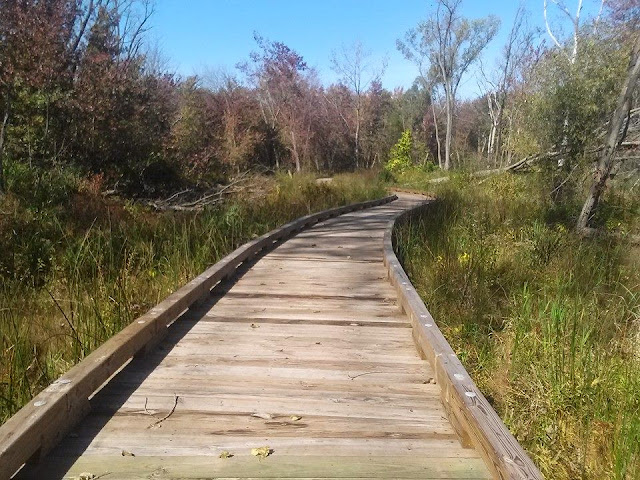On May 9, 2015 I went out with Dan Spencer, a resource ecologist from the Forest Preserves of Cook County to examine wetland graminoids in a marsh at Sand Ridge Nature Center in South Holland, Illinois. The preserve protects over 75 acres of wetlands in various conditions.
Graminoids are grasses and grass-like plants. We were particularly interested in
sedges and
rushes that were growing in a wetland area on the property.
Sand Ridge Nature Center is situated in the lake plain, a former lake bottom of the ancestral Lake Michigan. Over the past 6,000 years, Lake Michigan has been receding, and as it has done this it has left behind old sand deposits interspersed with wetland areas. The low-lying topography of the area as well as urbanization of the surrounding landscape has left much of the property of Sand Ridge Nature Center partially underwater for most or all of the year (figure 1).
 |
| Figure 1: Wetland area dominated by graminoids (grass-like plants) on either side of the Lost Beach Trail at Sand Ridge Nature Center. |
We traveled primarily along the elevated boardwalk portion of the Lost Beach Trail (figure 1). One of the first graminoids that poked our interest was
Carex stipida, a sedge growing in shallow water right beside the boardwalk.
C. stipida has a triangular shaped stem that is winged at the edges and has a spongy texture. The stem is also somewhat hollow, and the leaf sheafth (covering) is flat on the top and has a folded appearance.
C. stipida likes to grow in recently disturbed habitats, and it made sense that it was growing along the boardwalk which was installed only 2 years ago.
Eliocharis, the genus for the
spikerushes, was our next plant of interest and a species of it was growing in abundance along the boardwalk. Spikerushes have a fine and grass-like form and are round in cross-section (figure 2). Identifying spikerushes down to species can be very difficult and must often be done in a laboratory.
 |
| Figure 2: The form (habit) of a typical spikerush |
Another plant we encountered (which was also hard to identify with certainty) was Swamp Cress (
Cardamine bulifera). We found it growing in very shallow water, and it has very finely divided leaves (figure 3).
 |
| Figure 3: Swamp cress habit |
Swamp cress will produce a four-petaled white flower similar to a mustard. Hopefully, seeing the flowers will make it easier to identify.
Tussock sedge (
C. stricta) was also growing in abundance in shallow water, although again there was some uncertainty on its identification because another similar species of Carex also grows in the lake plain,
C. aquatis. Generally,
C. stricta would have a reddish tinge on the culm, and
C. aquatis would have separate organs for the sexes exceot for one of the spikes. Both species have rather showy yellow flowers (figures 4 and 5).
 |
| Figure 4: Habit of Tussock Sedge showing male and female spikes. |
 |
| Figure 5: Sedges in bloom in a wet area off of the Lost Beach Trail boardwalk. May 9, 2015. Sand Ridge Nature Center, Forest Preserves of Cook County. Note small but showy yellow flowers. |
I will be keeping my eye out for other types of wetland plants that emerge as the season progresses, but identifying graminoids will be an interesting challenge.








Comments
Post a Comment